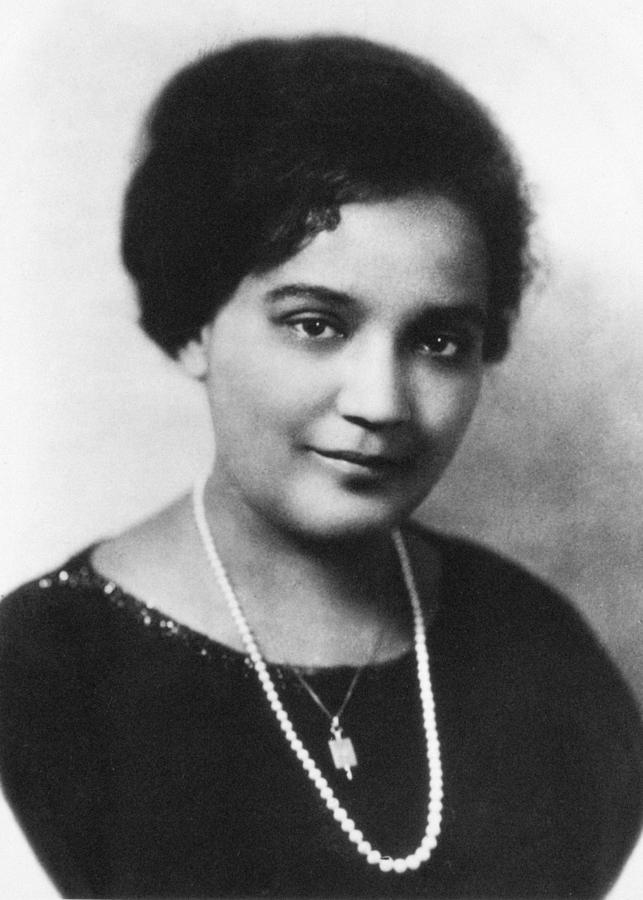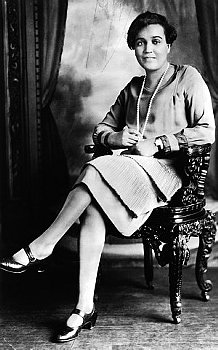<Back to Index>
- Writer Jessie Redmon Fauset, 1882
PAGE SPONSOR


Jessie Redmon Fauset (April 27, 1882 - April 30, 1961) was an American editor, poet, essayist and novelist.
Fauset was the editor of the NAACP magazine The Crisis. She also was the editor and co-author for the African American children's magazine Brownies' Book. She studied the teachings and beliefs of W.E.B Dubois and considered him to be her mentor. Fauset was known as one of the most intelligent women novelists of the Harlem Renaissance, earning her the name “the midwife”. In her lifetime she wrote four novels as well as poetry and short fiction.
Fauset was born on April 27, 1882 in Camden County, New Jersey. She was the daughter of Redmon Fauset, an African Methodist Episcopal minister, and Annie Seamon Fauset. Jessie’s mother died when she was a child and her father remarried. Fauset came from a large family mired in poverty. She attended the Philadelphia High School for Girls, and became the school's first African - American graduate. She wanted to study at Bryn Mawr College but they circumvented the issue of admitting a black student by finding her a scholarship for another university and so she continued her education at Cornell University. She graduated from Cornell University in 1905 with a degree in classical languages. It was speculated that she was the first black woman in the Phi Beta Kappa Society. Fauset later received her Master’s degree in French from the University of Pennsylvania.
Following graduation Fauset became a teacher at Dunbar High School in Washington DC, spending her summers in Paris studying at la Sorbonne. In 1919 Fauset left teaching and became the literary editor for the The Crisis alongside W.E.B. Du Bois until 1926. Fauset became a member of the NAACP and represented them in the Pan African Congress in 1921. After her Congress speech, the Delta Sigma Theta Sorority made her an honorary member.
Fauset married insurance broker Herbert Harris in 1929 at the age of 47. Harris died in 1958. She then moved back to Philadelphia with her stepbrother. Fauset died on April 30, 1961 from heart disease.
Jessie Fauset’s time with the Crisis is considered the most prolific literary period of the magazine’s run. In July 1918, Fauset became a contributor to the Crisis, sending articles for the “Looking Glass” column from her home in Philadelphia. By the next July, W.E.B. Du Bois requested she move to New York in order to become the full time Literary Editor. By October, Fauset was installed in the Crisis office, where she quickly took over most organizational duties. As Literary Editor, Fauset fostered the careers of many of the most famous authors of the Harlem Renaissance, including Countee Cullen, Claude McKay, Jean Toomer and Langston Hughes. In fact, Fauset was the first person to publish Hughes. A few of his early poems appeared in The Brownies’ Book, The Crisis’s children’s magazine edited by Fauset. In his memoir, The Big Sea, Hughes calls Fauset the “midwife” of the Harlem Renaissance, though the truth of this moniker has only recently been fully appreciated by critics.
Beyond nurturing the careers of other African American modernist writers, Fauset was also a prolific contributor to both The Crisis and The Brownies’ Book. During her time with The Crisis, Fauset contributed poems and short stories, as well as a novelette, translations from the French of writings by black authors from Europe and Africa, and a multitude of editorials. Fauset also published accounts of her extensive travels. Notably, Fauset included five essays detailing her six month visit to France and Algeria in 1925 and 1926 with Laura Wheeler Waring, though the best known of her travel writings must be her editorial detailing her visits to the Pan-African Congresses in 1921 and 1923.
After eight years as Literary Editor, conflicts between Fauset and Du Bois began to take their toll. In February 1927, Fauset left her position. She is instead listed as “Contributing Editor,” though this designation remains on the masthead only one month. From 1927 to 1944, she taught French at DeWitt Clinton High School in the Bronx, though she continued to publish.
Between 1924 and 1933, Fauset produced four novels: There is Confusion (1924), Plum Bun (1928), The Chinaberry Tree (1931), and Comedy, American Style (1933). Inspired by T.S. Stribling’s novel Birthright, Fauset recognized a dearth of positive depictions of African American experience in contemporary literature, and thereby set out to portray African American life as realistically, and as positively, as possible.
- Fauset's first novel, There is Confusion, was praised widely upon release, especially within the pages of the Crisis. This novel traces the family histories of Joanna Mitchell and Peter Bye, who must each come to terms with the baggage of their racial histories.
- Published in 1923, her second novel Plum Bun has warranted the most critical attention. Plum Bun centers on the theme of "passing." The protagonist, Angela Murray, eventually reclaims her African American identity after spending much of the novel passing for white.
- Fauset's third novel, The Chinaberry Tree, has largely been ignored critically. Set in New Jersey, this novel explores the longing for "respectability" among the contemporary African American middle class. The protagonist Laurentine seeks to overcome her "bad blood" through marriage to a "decent" man. Ultimately, Laurentine must redefine "respectable" as she finds her own sense of identity.
- Her last novel Comedy, American Style,
explores the destructive power of "color mania" The
protagonist's mother Olivia ultimately brings about the
downfall of the other characters due to her own
internalized racism.